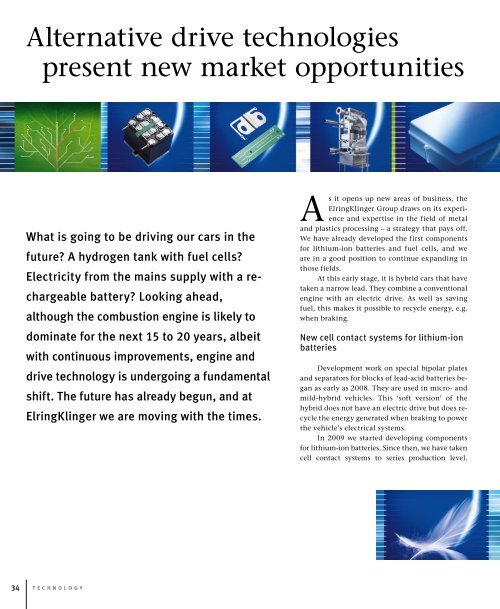THE STAFF MAGAZINE OF THE ELRINGKLINGER GROUP NO. 1 ...
THE STAFF MAGAZINE OF THE ELRINGKLINGER GROUP NO. 1 ...
THE STAFF MAGAZINE OF THE ELRINGKLINGER GROUP NO. 1 ...
Create successful ePaper yourself
Turn your PDF publications into a flip-book with our unique Google optimized e-Paper software.
Alternative drive technologies<br />
present new market opportunities<br />
What is going to be driving our cars in the<br />
future? A hydrogen tank with fuel cells?<br />
Electricity from the mains supply with a re-<br />
chargeable battery? Looking ahead,<br />
although the combustion engine is likely to<br />
dominate for the next 15 to 20 years, albeit<br />
with continuous improvements, engine and<br />
drive technology is undergoing a fundamental<br />
shift. The future has already begun, and at<br />
ElringKlinger we are moving with the times.<br />
34 TECH<strong>NO</strong>LOGY<br />
As it opens up new areas of business, the<br />
ElringKlinger Group draws on its experience<br />
and expertise in the field of metal<br />
and plastics processing – a strategy that pays off.<br />
We have already developed the first components<br />
for lithium-ion batteries and fuel cells, and we<br />
are in a good position to continue expanding in<br />
those fields.<br />
At this early stage, it is hybrid cars that have<br />
taken a narrow lead. They combine a conventional<br />
engine with an electric drive. As well as saving<br />
fuel, this makes it possible to recycle energy, e.g.<br />
when braking.<br />
New cell contact systems for lithium-ion<br />
batteries<br />
Development work on special bipolar plates<br />
and separators for blocks of lead-acid batteries began<br />
as early as 2008. They are used in micro- and<br />
mild-hybrid vehicles. This ‘soft version’ of the<br />
hybrid does not have an electric drive but does recycle<br />
the energy generated when braking to power<br />
the vehicle’s electrical systems.<br />
In 2009 we started developing components<br />
for lithium-ion batteries. Since then, we have taken<br />
cell contact systems to series production level.




